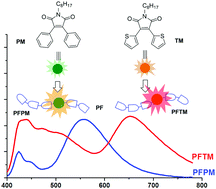Diarylmaleimide fluorophores: intensely emissive low-band-gap guest for single white polymers with highly efficient electroluminescence†
Abstract
A series of novel single white polymers, PFPMs and PFTMs, were designed and synthesized by introducing a green diphenylmaleimide (PM, λem = 500 nm) or yellow dithienylmaleimide (TM, λem = 557 nm) fluorophore guest into a blue polyfluorene (PF) host. By adjusting the feed ratio of the maleimide unit and fluorene unit, the resulting single white polymers exhibited a dual emission, including blue emission (415/439 nm) from PF and yellow (546 nm) or red (659 nm) emission from the PM or TM guest. The large red-shift in emission of the PM and TM in the backbone of the polymers originates from their conjugated structure being extended by the fluorene units. All the polymers show similar and high thermal stability and large solubility in common organic solvents. Their electroluminescent properties were investigated in single-emitting-layer devices fabricated by a solution process with the configuration of ITO/PEDOT:PSS/polymer/TPBI/LiF/Al. PFPM03, containing 0.3% PM, exhibited an excellent white electroluminescent performance for the effective and incomplete energy transfer from the PF host to the maleimide guest. The white device based on annealed PFPM03 at 140 °C for 30 min could be further improved to reach a maximal current efficiency of 8.14 cd A−1, power efficiency of 3.93 lm W−1, and external quantum efficiency of 3.78% with CIE coordinates of (0.34, 0.41).


 Please wait while we load your content...
Please wait while we load your content...